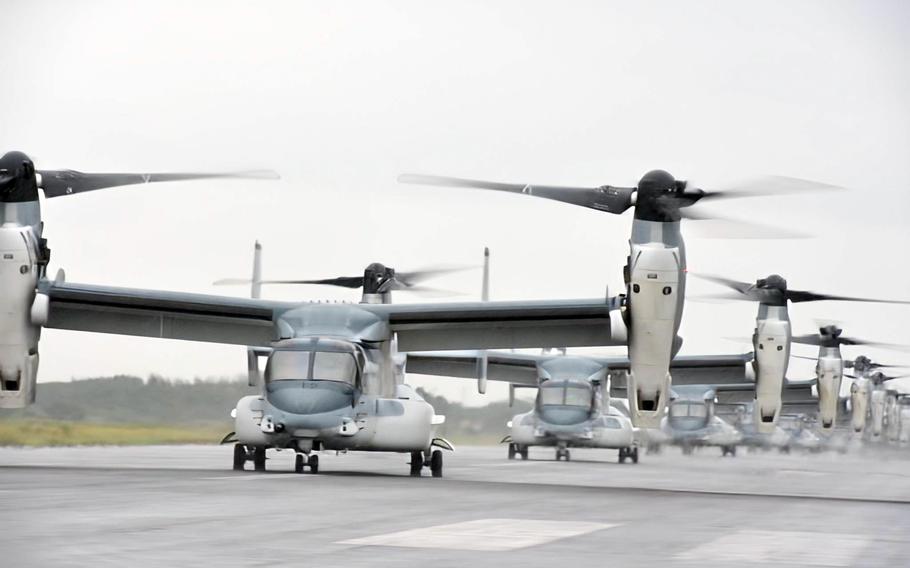The Japan Ground Self-Defense Force (JGSDF) has grounded its fleet of Osprey tiltrotor aircraft after one of its V-22 Ospreys sustained damage during a failed takeoff attempt as part of the ongoing “Keen Sword 25” joint exercise with the United States.
The incident, which occurred on October 27, highlights the operational risks of the Osprey fleet and has prompted an investigation by Japan’s Defense Ministry.
During the drill, at approximately 11:38 a.m., the V-22 Osprey assigned to the JGSDF’s 1st Helicopter Brigade attempted a takeoff from the Yonaguni Garrison on Yonaguni Island. However, the aircraft became unstable, tilting from side to side.
As a result, the lower portion of its left wing made contact with the ground, causing structural damage to the aircraft, according to a Japan Joint Staff Office report. The JGSDF pilot halted the flight immediately, and the Osprey landed safely within the garrison’s perimeter.
In a press conference held on October 29, Japan Defense Minister Gen Nakatani confirmed that the JGSDF’s fleet of Ospreys had been grounded.
https://twitter.com/muki46/status/1850755537924743232
The JGSDF accident investigation committee is currently examining the cause of the incident, and officials have stated that flights will remain suspended until the investigation clarifies the reason for the accident and appropriate safety measures are implemented.
The US military later disclosed that three US Marines were onboard the Japanese Osprey during the failed takeoff, alongside thirteen other military personnel.
According to the Joint Staff spokesman, no injuries were reported.
The incident marked the first recorded case of a Japanese Osprey sustaining damage in this manner, although officials did not specify if any prior incidents of other damage had occurred with the fleet.
The grounded Ospreys had been scheduled to participate in air assault drills during the Keen Sword exercise, which includes exercises aimed at enhancing the interoperability of US and Japanese forces.
This year’s Keen Sword exercise, in particular, planned for both US and Japanese Osprey pilots to operate jointly from Yonaguni Island. This island is strategically located southwest of Okinawa and is the closest Japanese island to Taiwan.
Keen Sword is a biennial military exercise that has been held since 1986. It aims to enhance combat readiness and foster collaboration between US and Japanese forces.
The grounding of Japan’s Osprey fleet affects JGSDF operations within the joint exercise, but the US military has affirmed that its own Ospreys in Japan remain mission-ready.
US Forces Japan stated that the American aircraft would continue their scheduled participation in the exercise, with minimal disruption anticipated. The command noted its commitment to conducting realistic and comprehensive training exercises with allies and partners in the region.

Renewed Concerns Over Safety
A recent incident involving a Japanese Osprey has reignited debates in Japan about the safety of this tiltrotor aircraft, which is operated by both the US and Japanese military.
The incident unfolded just as US Ospreys were beginning to resume a more regular flight schedule in Japan. Earlier this month, American Ospreys from Yokota Air Base, located in western Tokyo, made their first flight to Okinawa since a fatal accident in Nov 2023.
The Osprey fleet had been grounded between December and March following the tragic crash on November 29, 2023, when a US Special Operations Command Osprey went down off Yakushima, an island south of Kyushu, resulting in the loss of all eight crew members.
The official report indicated that the crash was caused by a severe mechanical failure, which was further aggravated by the crew’s “lack of urgency” in responding to the situation.
The Bell-Boeing tiltrotor aircraft, more commonly known as the Osprey, has a troubled history, with a record of numerous fatal accidents since its first flight in 1989.

Despite its critical role in various military operations, the Osprey has been beset by a range of safety issues, earning it the unfortunate nickname “the widow-maker.”
This reputation has only been amplified by recurring technical problems, particularly with the gearbox system, which have led to public concerns in Japan and the US regarding the aircraft’s dependability.
One persistent issue with the Osprey has been “hard clutch engagement,” a malfunction where the clutch disconnects from the rotor system and unexpectedly re-engages, resulting in a dangerous drop in altitude and potential loss of lift.
The CV-22 Osprey model has two prop-rotor gearboxes within each rotating engine nacelle, enabling the aircraft to take off and land like a helicopter but fly like an airplane.
However, the complex transmission system has led to numerous failures over the years, with the interaction of the aircraft’s engine, weight, and vibration placing significant stress on its gears and driveshafts.
In February 2023, military officials announced they were 99% confident they had addressed the “hard clutch engagement” issue by mandating the replacement of a component known as the ‘input quill assembly’ after every 800 flight hours.
However, despite this modification, questions about the Osprey’s reliability and safety remain unresolved. The absence of a conclusive solution has fueled public apprehension, especially among Japanese communities near US military bases, who fear the risk of future accidents.
- Contact the author at ashishmichel(at)gmail.com
- Follow EurAsian Times on Google News




